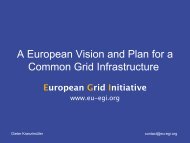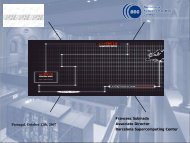e-Infrastructures Roadmap - Internet Society Nederland
e-Infrastructures Roadmap - Internet Society Nederland
e-Infrastructures Roadmap - Internet Society Nederland
- No tags were found...
Create successful ePaper yourself
Turn your PDF publications into a flip-book with our unique Google optimized e-Paper software.
e-<strong>Infrastructures</strong> <strong>Roadmap</strong>Why should Europe join forces?It takes a lot of effort to try to combine resources scattered across the continent. Why do we take allthis trouble? The answer is simple: there is a long term huge structural need for a variety of resourcesthroughout all scientific domains that can be best satisfied that way. It is a given that we already havemany resources deployed. With an e-Infrastructure in place we can use them smarter and far morecost efficient at the same time – thereby giving a higher return on investment and increasing theirpotential. Adopting the grid paradigm will allow us to think global and act local.Below we will try to give a number of reasons why an integrated approach to ICT infrastructure ispreferable over others. One such reason is that investments on the national scale have proven to beinsufficient to provide world class resources to European scientific communities even though totalEuropean expenditure is up to par. Another is that the sustained demand for resources on a Europeanlevel requires a structural approach that solves the huge inefficiency that pressures individual sciencedomains to justify their own facilities over and over again. Another is that a European sharedapproach will yield a faster time-to-science because of pooling resources while lowering pricesthrough just-in-time acquisition.National scale is too smallEven though the European economy as a whole is very strong indeed, individual European countriescannot sustainably provide world class resources to their scientific communities by themselves.An area where this is clearly visible as a trend with data available over a long time is supercomputing.There has been a significant gap between the fragmented European supercomputer facilities andwhat leading sites in Japan and the USA have had available for the last decades. Computers at the verytop of the market cannot be funded by a single European country; they have to be supported bymultiple nations and need to be co-financed on a European level. There is an urgent need for theEuropean Commission and the member states to review and bridge that gap. Similarly, there is a lackof variety of supercomputers from the point of architectures that are available in Europe. Scale getseven more important if Europe is to undertake some grand challenges: large scale scientific endeavoursthat can push the boundaries of science significantly further. A European focus can make such undertakingshappen.Sustained growth in volume requires a structural solutionWhen one looks at the figures, the overall picture is clear. The investments in e-Infrastructurecomponents in Europe have relentlessly risen in the last two decades – without a single dip.The systems and networks may have gotten much cheaper, but demand has been growing even faster.Some key figures: investments in networking are now at about 0.4 billion Euro annually for GÉANTand the networks run by NREN’s alone (so excluding the fine-grained ‘campus-level’ deploymentwhich is the most expensive). The current installed base for supercomputers and very large clusters inEurope (200 largest European computer system currently in place) is worth over 0.6 billion Euro. 7This is without operational costs such as maintenance or power consumption taken into account, andat current price levels – of course what was actually paid for these systems at the time of purchasewill have been a multiple of that amount. In the EU FP6 0.65 billion Euro is spent on large Research<strong>Infrastructures</strong>, 8 of which significant amounts go to ICT components. A single sensor network alonecan have a budget of 0.15 billion Euro, of which about one third may go to special supercomputingfacilities. 9Clearly, the sustained nature of these investments and the technical overlap among many of theseactivities justifies coordination and consolidation. It is very inefficient if every scientific domain thatrequires some large facility has to find justification and political leverage to obtain funds, and thenbuilt the expertise to make the right choices for huge one time investments. 10 Such a procedurecosts a lot of time and money, which also makes that emerging sciences are at a disadvantage.Once investments are made, new insights may dictate starting all over again. Centralised facilities thatare instantly available at a fair price without the need for everyone to go through the wholeoperation will make science more effective. 117 Estimate derived from the ARCADE-EU database, www.arcade-eu.org.8 See: www.cordis.lu.9 See: www.lofar.org.10 An example of collaboration on a European level is the European Centre for Medium-Range Weather Forecasts(ECMWF), which is a co-operation of 24 European national meteorological institutes. ECMWF operates a state-of-thearthigh-performance computer, which always belongs to the top systems in Europe.12 11 In the case of supercomputing facilities commercial offerings from companies like IBM and SUN in this area have recentlyseen the light. If the case for a specifi c type of resource cannot be made, one could look at the market to supply it.13







